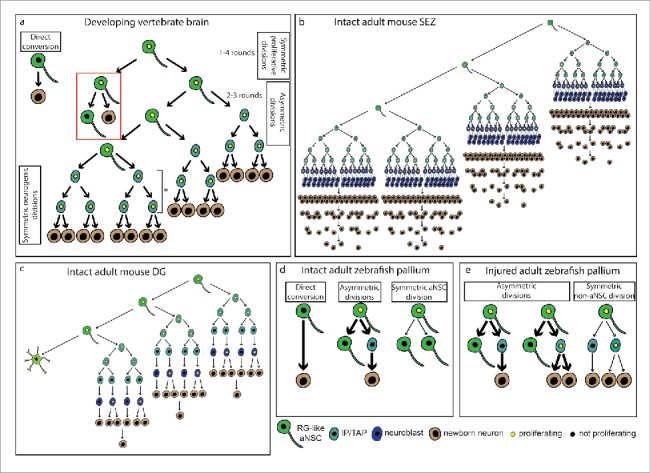Figure 2.

Neuronal output of single NSCs. (a) Different modes of neuron generation in the developing brain. In the zebrafish hindbrain and Xenopus optic tectum, some NSCs directly convert into neurons (direct conversion), depleting themselves. At early embryonic stages in the zebrafish and mouse telencephalon, NSCs proliferate (1–4 rounds in the mouse) to increase their number (symmetric proliferative divisions).18,26 As development advances, NSCs divide asymmetrically to give rise to another NSC and a neuron directly (direct neurogenesis, red box) or to a NSC and an intermediate progenitor, that amplifies the neuron production (indirect neurogenesis). In the mouse cortex, NSCs can undergo 2–3 rounds of asymmetric division.26 The degree of amplification via intermediate progenitors differs in the cortex and the ventral telencephalon of the mouse (asterisk), since cortical IPs divide once or twice before generating neurons, whereas in the lateral ganglionic eminence they divide several times. At the end of neurogenesis, most NSCs undergo a terminal division (symmetric neurogenic divisions). (b) NSC lineage in the adult mouse SEZ. Adult NSCs have a limited self-renewal capacity, and generate neurons via transit amplifying progenitors (TAPs) and neuroblasts. Despite the high degree of amplification, many neurons die and only a few manage to survive and integrate in the olfactory bulb circuits.15 (c) NSC lineage in the adult mouse DG. In this region aNSCs undergo a few rounds of asymmetric divisions to generate neurons via intermediate progenitors, after which they terminally differentiate into astrocytes. Compared to the SEZ, there is a lower amplification at the intermediate progenitor level.13,21 (d) Modes of neurogenesis and division in the intact adult zebrafish pallium. Neurogenesis occurs either through direct conversion, depleting the NSC, or asymmetric division, maintaining the aNSC. Besides the self-renewing asymmetric division, NSCs also undergo symmetric amplifying divisions (symmetric aNSC division). The thickness of the arrows represents the relative frequency of each behavior. (e) Modes of neurogenesis and division in the injured adult zebrafish pallium. After injury, aNSCs divide not only asymmetrically, as in the intact brain, but also symmetrically to generate two intermediate progenitors, increasing the neuronal output. The thickness of the arrows represents the relative frequency of each behavior. Abbreviations: aNSC-adult neural stem cell; DG-dentate gyrus; IP-intermediate progenitor; RG-radial glia; SEZ-sub-ependymal zone; TAP-transit amplifying progenitor.
